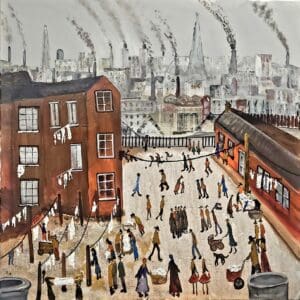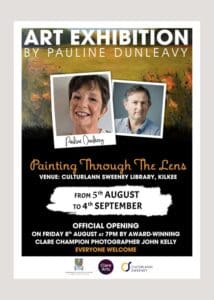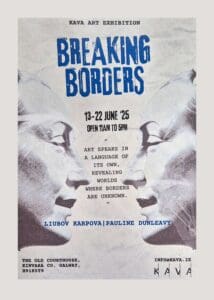Are Big Art Fairs Worth It? The Real Maths Irish Artists Should Do Before Booking a Stand
Art fairs promise footfall, “serious buyers,” and a weekend that could transform your career. The reality? Many fairs deliver exposure while artists shoulder all the financial risk. That doesn’t make fairs a scam—but it can make them a bad business decision if you don’t run the numbers.
This guide is written for Irish artists (hello, Dublin, Cork, Galway, Limerick 👋) who are weighing up big-ticket fairs—think large, multi-day events in venues like the RDS—against smarter, lower-risk ways to grow sales. No drama. Just the maths, the psychology, and a decision checklist you can use today.
The Promise vs. The Product
What fairs sell to the public: a great day out, lots of art, demos, talks.
What fairs sell to artists: hope. Footfall numbers. Phrases like “great buying audience” and “serious collectors attend.” But the actual product you buy is floor space—not sales. The organiser gets paid upfront; you carry the risk.
If the event truly believed every artist would sell well, they’d share risk (e.g., lower fixed fees + small commission). Most don’t.
Quick “Break-Even” Maths (Use This Before You Apply)
Estimate your real cost (example figures—swap in your own):
-
Stand fee: €600–€900
-
Electric/lighting/insurance/extras: €80–€200
-
Transport/parking: €40–€150
-
Printing/cards/brochures/packaging: €30–€120
-
Framing/presentation upgrades: €100–€300
-
Accommodation (if needed): €0–€300
-
Time (3 days + prep) — value your time, even modestly: €200–€450
Example total outlay: €1,050–€2,420
Now ask:
-
What’s my average selling price? (e.g., €350)
-
How many pieces must I sell to hit break-even?
-
If total outlay ≈ €1,500 and ASP = €350 → ~5 original pieces
-
-
Is that realistic given my category and the fair’s audience?
-
Do I have add-on products (prints/cards/smalls) to catch lower budgets?
If your honest answer is “maybe,” then the fair is a marketing expense—not a sales engine. Budget accordingly.
Why It Can Feel Like a Con (Even If It Isn’t)
The risk is asymmetrical
Organisers get paid regardless. Artists pay and hope.
“Exposure” is not an outcome
Footfall doesn’t equal buyers. A large % are browsing, not collecting.
Uneven stand value
Front rows, entrances, and near food get more traffic. Back corners don’t. Fees rarely reflect that reality.
You become the content
Artists supply the art, the colour, the demos, the social buzz—then the organiser sells tickets using your effort.
Soft costs compound
You count the stand fee, forget the rest. By Sunday, your real cost is double what you expected.
What Actually Converts at Fairs (And What Doesn’t)
Converts
-
Clear, simple price points with visible labels
-
A range of entry-level buys (€20–€80) to warm browsers
-
Mid-priced hero pieces that look fantastic from 2–3 metres
-
Easy payment options (card reader, tap to pay)
-
Confident, short conversations + take-home materials
-
A compelling story hook: place, process, purpose
Doesn’t Convert
-
Complex hanging with tiny labels and no pricing
-
Only large, high-ticket works (with no smaller path to purchase)
-
Overlong pitches (people feel trapped)
-
“Take my card” without a follow-up plan
-
Hoping the organiser’s audience is your buyer (often it isn’t)
When A Big Fair Can Be Worth It
-
You already have a warm audience and you’ll drive them to your stand
-
Your offer ladder is ready: prints/cards/smalls + mid-range + 1–2 large
-
You treat the weekend as marketing + networking + content creation (not just sales)
-
The fee is money you can risk without anxiety
-
You’ve booked a good stand position (and confirmed exact location)
-
You’ll follow up with every lead within 48 hours
A 10-Point Decision Checklist (Copy/Paste This)
-
Total cost (all-in): €________
-
Average selling price (ASP): €________
-
Break-even units (Total ÷ ASP): ________
-
Price ladder ready? (smalls, mid, large) Yes / No
-
Stand position confirmed & acceptable? Yes / No
-
Card payments & packaging ready? Yes / No
-
Lead capture ready? (QR → mailing list, sign-up sheet) Yes / No
-
Follow-up plan within 48 hours? Yes / No
-
You can live-post content? (photos, reels, short lives) Yes / No
-
If you sell nothing, is the marketing value still worth €X? Yes / No
If you tick No on more than three lines, reconsider.
Smarter Alternatives (Often Higher ROI for Irish Artists)
-
Curated pop-ups with 3–6 artists; split rent and marketing
-
Local group shows (low fees, targeted audience)
-
Open studios (the most interested buyers are the ones who visit you)
-
Online marketplaces with low or 0% commission on Premium plans (e.g., Irish Artmart)
-
Partnerships with cafés/boutiques/interior designers (rotating hangs)
-
Consignment in destination venues with real buying traffic
-
Host your own mini-launch: one evening, RSVP list, one special piece
If You Do Book a Fair, Make It Pay
Before
-
Negotiate exact stand location (map it)
-
Design a clear wall plan (1–2 hero pieces; less is more)
-
Prep a story card: 30–50 words that sell why you
-
Price visibly. Don’t make people ask.
-
Create an email sign-up mechanic (QR → landing page with a “fair-exclusive” perk)
During
-
Greet fast, keep it light: “Hi! Any favourite pieces so far?”
-
Offer a small take-home (mini prints, postcards)
-
Capture leads: “Want the catalogue with sizes/prices? QR here.”
-
Shoot vertical video of your stand for reels—1–2 per day
After (within 48 hours)
-
Email every lead: 3–4 images + prices + easy next step
-
Post a “last chance” recap with 2–3 available works
-
Send a personal note to anyone who lingered on a piece
A Simple Budget Worksheet (Example)
-
Fixed stand fee: €________
-
Electricity/lighting/insurance: €________
-
Transport/parking: €________
-
Printing/packaging/cards: €________
-
Framing/presentation: €________
-
Accommodation (if any): €________
-
Food/incidentals: €________
-
Time value (your day rate × days): €________
Estimated total: €________
Plan:
-
Smalls (qty × price): ___ × €___ = €___
-
Mid-range (qty × price): ___ × €___ = €___
-
Large (qty × price): ___ × €___ = €___
Target revenue: €________ → Target profit (Revenue − Total): €________
If profit target looks shaky before you go, it usually won’t improve on the day.
The Bottom Line
Large fairs aren’t inherently bad—but they are expensive ways to rent attention. For many emerging artists, the numbers simply don’t stack the first (or second) time. You’re paying to be one wall among a hundred, in front of a mixed audience, with no guarantee the organiser’s crowd is your buyer.
If you love the buzz and you can afford the fee as marketing spend, go in with a plan and a follow-up system. If you’re looking for profit first, consider lower-risk routes and build your audience where you keep more of the sale.
Where Irish Artmart Fits In
If your goal is to sell more art without losing margin, Irish Artmart offers:
-
0% commission on sales with Premium membership (€40/year)
-
Your own storefront & URL
-
Your own dashboard and contact form for buyers
-
Space to build a consistent online presence while you choose in-person events that actually serve your buyer
Set up your store, list your work, and focus on the moments that matter: making art and building genuine relationships with collectors.
*For collaborations, art features, or inquiries, please contact us at in**@**********rt.ie. Don’t forget to follow us on Instagram, Facebook, Twitter.
Disclaimer: The views and opinions expressed in this article do not necessarily reflect the official policy or position of Irish Artmart.
Irish Artmart – Your Gateway to Artistic Excellence.



